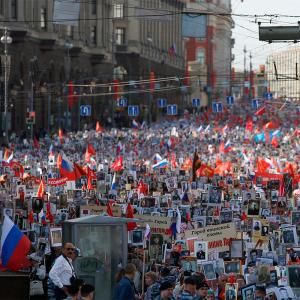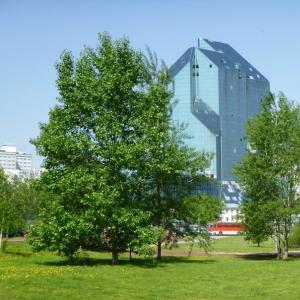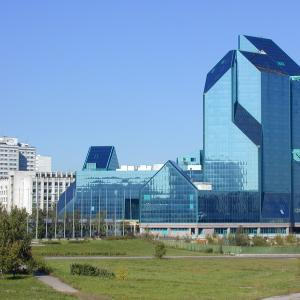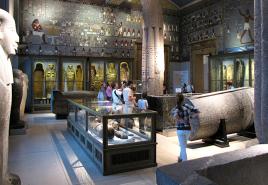Dress rehearsal. The "dress rehearsal" of the v-a-c foundation begins in mmoma What and how they are combined with the v-a-c collection and mmoma
Preparing for the launch of the site at HPP-2 in 2019, the V-A-C fund ventured to dilute the team of professional curators with intellectuals from outside. And while the third floor of MMOMA housed 200 classic works of the 20th century, from Andy Warhol and Alighiero Boetti to Eric Bulatov and Vadim Sidur, the exposition changed three times on the second floor. In April, theatrical artists from "" showed Chekhov's vigorous "The Seagull" with works of art in the roles of Treplev and Arkadina. In June, Austrian Armen Avanesyan turned art objects into illustrations for ultra-intellectual essays on the projects of the future that define our present.
The final act of the exhibition opened on July 27. Its author is Maria Stepanova, poet and editor-in-chief of Colta.ru, author of the documentary prose "In Memory of Memory", which was shot at the end of last year. Stepanova diluted works of art with household items from her attic, turning the exhibition into a poetic text about the dissolution of memory and history. The Village talks about Nobody - and sums up the whole V-A-C and MMOMA project.
Marketing and Marketing
Zurab Tsereteli's orthodox sculptures always create an awkward counterpoint to the exhibitions in the building at 25 Petrovka Street. But at the opening of the third act of "General Rehearsal", the imperial emptiness of the MMOMA courtyard was replaced by the seething city life. The imposing crowd swam cheerfully between the stalls with crocodile leather shoes, neon-colored blazers and handcrafted faux-aged jewelry.
The decision to combine the vernissage of an intellectual project with the seasonal Vintage Marketplace says a lot about the V-A-C foundation. Although the market basically runs between sites like MMOMA and the Stanislavsky Electrotheatre, the collapse could seem like an obvious profanation of Stepanova's ideas.
“What does an object gain and what does it lose when it finds itself in a museum collection? He gets an extended life, of course, and even a kind of immortality - which boils down to the very idea of \u200b\u200bbeing chosen: now a picture or a comb officially belongs to the collection of the unforgettable, is withdrawn from the everyday circulation - they were gizmos, became objects, "Stepanova wrote in the introductory essay to the exhibition ... What does an object gain and lose when it finds itself at a flea market under the windows of a museum?
In radical art circles, the oligarch Leonid Mikhelson's foundation is criticized for the lack of transparency in relations with the authorities, the duality of the political agenda and the privatization of young artists who, starting to collaborate with V-A-C, often abandon all projects on the side. But V-A-C certainly plays a significant role in the popularization of contemporary art, which Garage began ten years ago.
The two-day vintage market, backed by a public program of film screenings, concerts of contemporary music, open courses on sovrisk for teenagers and retirees, is another marketing ploy. The magic here lies in the fact that along the way he develops not only the concept from Stepanova's essay, but also the idea of \u200b\u200bfixing the entire “General Rehearsal” - an orientation toward horizontal work and distrust of hierarchies. The point is not that there is no difference between clothing and art objects, but rather that the essence of this difference should be constantly formulated anew for oneself.

Things and people
Three translucent shirt-fronts, a dull two-meter mirror, a huge light bulb polished to shine - in the very first hall it is striking that the main motive for comparing art objects with each other and with everyday things for Stepanova was purely sensual parameters. The texture of the material, transparency, color - all this turned out to be more important than the political content of the works or the historical context.
In the next room "Displacement" by Liz Deschens and "Annual Lamp" by Alighiero Boetti are replacing "Bread" by Anatoly Osmolovsky. A heavy beige "knitted envelope" rhymes with a set of massive sculptures that repeat the structure of pieces of Borodino bread. The principle of free rhymes is preserved in all 12 rooms - except that sometimes it turns not to sensuality, but to other parameters. For example, in one of the halls, a colorful and heavily shabby costume for an amateur ballet is combined with Anago's Costume by the same Boetty and Shemovich's Concert for New York.
Stepanova views such speculations as an attempt to equalize things with each other, to make each of them worthy of attention. “[What happens] if functionality, history and value are taken away from things? [Then they will surround] us with a crowd, a forest of meanings, lined up for the first time in a colonnade of complete, selfless equality. "
A deep, sometimes even hysterical love for gizmos from the past was the dominant message of an hour and a half public conversation between curators from V-A-C and Stepanova. "I sit and fidget: when will it be possible to go and look for a T-shirt?" - she answered the audience's question about whether the market under the windows was embarrassing.

But the relationship with memory is a cross-cutting motive of all Stepanova's work, which has recently begun to gather in final projects. At the end of last year, after a collection of selected poems "Against the Lyrics", the book "In Memory of Memory" was published - the result of 20 years of attempts to get used to the history of his own family since the beginning of the last century and attentive polemics with other essayists and artists from Susan Sontag to Winfried Sebald. The result was “the best Russian prose of the year (yes, perhaps, and not only this one)” (Lev Oborin on Meduza), “a book that really didn't exist in Russian before. And in other languages \u200b\u200bit is not that there are many "(Anna Narinskaya in" Novaya Gazeta ").
Those who read the romance (this is the author's designation of the genre) at the exhibition will recognize things from the suitcases of Stepanova's great-grandmother or her own purchases. But in the book, each of the little things is given a couple of lines, sometimes a paragraph. They always turn out to be only evidence of people's lives.
The format of the exhibition transfers all the attention to things, and an attempt to fit into the general installation of the "General Rehearsal" on object-oriented thinking, in which the value of things and even their ability to act independently do not depend on the connection with people, allows Stepanova's fix idea to add another semantic layer ... However, it is not painless: “These things, which had owners, are now very alien, or nobody's. They are now legally called "Japanese kimono, 1910s", and not "kimono such and such, acquired then." This is a separation process ... ”- says Stepanova.

Object oriented poetry
I entered the sixth hall - almost the equator of the composition, which is divided into two parallel lines of rooms - with a long-defined intention. Immediately at the entrance, one had to turn around in order to look through the entire corridor from the openings into the very mirror "Displacement" and see, instead of a slightly blurry reflection, a black spot of the crowd of visitors.
At the beginning of the exhibition, the curators of the "Dress Rehearsal" designated as their main task "the introduction of a time dimension into the process of presenting art in a museum." Then the theater metaphor seemed to be the key. Then it became clear that the structure of the museum still does not favor pure theatricality, where the flow of time is strictly set by the director, and the philosopher and poet simply did not write the play.
But Stepanova's act seems to be the most important work with a time dimension. There is no consistent development of reasoning, as in Avanesyan, or a set of sketches-commentaries to the play, as in TVD. Stepanova raised her favorite thesis as a principle: "everything rhymes with everything." "Nobody" unfolds in time and space, like a good poetic text: each new hall changes the meaning of the previous one, forcing you to return and check your memory for truth.
Perhaps this actually happens at any exhibition. But this is the magic of interdisciplinarity: it is Stepanova's attitude to poetry that allows one to clearly understand this feature. And if in questions of "restoring justice" in the life of things, the agenda of object-oriented ontology seemed drawn, then a poem, where objects and their properties have replaced words, is an impressive discovery.

Two halls, which represent the most interesting of Stepanova's intuitions about museums, I would like to compare with the brightest and most capacious phrases that are usually found in every worthy poetic text.
At the entrance to the tenth - the largest, it became a culmination in the two previous acts - visitors are greeted by the reverse sides of eight massive abstract paintings: chips, inscriptions, author's autographs. The senior curator of V-A-C Katerina Chuchalina said that a whole research project of the foundation grew out of this idea of \u200b\u200bStepanova. For each of the paintings, its history was written as things: movements, owners, life in vaults. These short and rather poetic essays, clearly edited by Stepanova herself, accompany traditional curatorial explications here.
And the fifth room, which contains six well-known portraits, turned out to be the most theatrical. Valentina Matvienko performed by Vladislav Mamyshev-Monroe and Beatrice Hastings by Modigliani is offered to be watched in individual booths.
“A museum visitor is in a contractual relationship with his Gioconda: he comes, he pays, he spends some (limited, etiquette) time with her, hoping to get an impression and make it as rich as possible.<...> The intimate space that can be built between a person and a picture is narrowed to the limit, reduced to a ten-minute look over someone else's shoulder, ”Stepanova comments on the idea of \u200b\u200bthis hall in the libretto. After half a minute of my contact with Richard Avedon's Marella Agnelli, for some reason a caretaker peeked behind the heavy pink blinds, and I found that my gaze was directed not at the photograph behind the glass, but at the messenger.

First run
When I reached the last room in the Nobody's room for the third time, an impressive group of visitors stood between the human figures from the sculpture of Louise Bourgeois (Child. Woman) set opposite each other. One of them threw questions at the mediator, gradually moving from clarifications about the fate of the unfinished knitting exhibited in this room to general skepticism about the curatorial concept.
The "dress rehearsal" is indeed open to doubt. In the second half of the act, Stepanova's intuition is clearly exhausted, repeating ideas from the first rooms with almost no variations. The central idea of \u200b\u200binterest in things by themselves, regardless of their owner and history, collides at least with labels, each of which is signed: "Collection of Maria Stepanova."
And the general obvious amateurism in "Nobody" immediately resembles the first act: Modigliani's painting as Arkadina and Jeff Koons' huge kitsch animals as a manifestation of "lions, eagles and partridges" then also raised ironic questions. Both Stepanova and the Theater of Mutual Actions quite boldly opposed themselves to the conceptual coldness of the sovrisk.

"Do artists know the role in which their work is presented at an exhibition?" - constantly asked on the public program and in interviews with the curators of V-A-C. Many artists know. But more importantly, the exhibition, thanks to dense explications, also retains its usual mode of perception. So, in the end, the choice is up to the visitor himself. The mantra about the production of freedom, which is often repeated in artistic circles, is embodied very concretely. And, by the way, that is why the first and third acts seem much more alive than "Metaphysics from the Future" by Avanesyan, who, having elevated art objects to the status of an argument to a philosophical idea, only increased the degree of general abstraction.
By the end, the six-month project V-A-C and MMOMA begins to seem like an enlarged copy of one of its parts. The third floor, a repository where, in a small space, works that were not included in the act are literally piled up in a heap, is a set of masterpieces that are frankly cramped in the chaotically and in places controversially organized eight sections. A set of disparate intuitions about different modes of perception of sovrisk, about new curatorial methods, about revitalizing public programs can only be dealt with by the very “introduced time dimension” - the gradual deployment of project acts, and not a one-time shock injection.
Therefore, the "Dress Rehearsal" is rather the first run: a lot of ambitious ideas that have yet to be razed. To discard the unsuccessful ones, and from the best to grow an interdisciplinary museum of the future.
Photos: cover, 2 - 7 - Mark Seryi / MMOMA, 1 - Ivan Novikov-Dvinsky / MMOMA
DRESS REHEARSAL
PRESENTATION IN THREE ACTS.
WORKS FROM COLLECTIONS V-A-C, MMOMA AND KADIST
|
Dan Vo (b. 1975), We are the People, 2011.  Chiara Fumay (born 1978) "A male artist is a clear contradiction", 2013.  Lucy Mackenzie (b. 1977)  Wael Shawki (b. 1971) Cabaret Crusades III: Secrets of Karbala (puppet), 2014.  Mamyshev-Monroe Vladislav Yurievich (1969-2013), Borisov Sergey Alexandrovich (Photographer) (1947) |
On April 26, a cross-disciplinary project of the V-A-C Foundation and the Moscow Museum of Modern Art - "Dress Rehearsal", opens at MMOMA on Petrovka 25. Borrowing the structure and techniques of theatrical production, he revises the established ways of exhibiting art and interacting with the audience. The “dress rehearsal” is divided into three acts and offers to look at works of art as actors with their own biography, character and roles that change depending on the scenario.
The curators of the "Dress Rehearsal" invited three authors to write scripts for three acts, choosing as characters any of 200 works from the collections of V-A-C, MMOMA and the KADIST Foundation. The key to the scenes played out in the halls of the second floor of the Moscow Museum of Modern Art will be the libretto, as is customary in the theater. On the third floor there will be an open storage, where visitors will see all the works not involved in the performances. The text for the first act, which will run from April 26 to June 17, was written by the "Theater of Mutual Actions" association (Shifra Kazhdan, Ksenia Peretrukhina, Lesha Lobanov, Alexandra Moon) based on the play by A.P. Chekhov's "The Seagull". On June 21, the second act starts according to the script of the Austrian philosopher Armen Avanesyan. The third act will begin on July 27 and will be written by the writer and poet Maria Stepanova.
The "dress rehearsal" is conceived as a living organism that changes under the influence of the environment. The project pays great attention to working with visitors who will be able to form their own judgment in dialogue with mediators. The five months of the “General Rehearsal” will be full of events of the public program, including performances, concerts, film screenings, reading and phono groups, workshops, lectures, discussions, classes with children and older visitors.
A single ticket to the exposition costs 350 rubles. The cost of a subscription that allows you to visit each of the three acts of the project once is 600 rubles. Admission to all events of the public program is free, by prior registration.
The "Dress Rehearsal" project was prepared by a group of VAC and MMOMA curators: Elza Abdulkhakova, Varvara Ganicheva, Diana Dzhangveladze, Maria Doronina, Polina Zotova, Anna Ilchenko, Daria Kalugina, Maria Kramar, Francesco Manakorda, Anna Panfilets, Andrey Parshikov, Anna Repina-Galenkina Olga Stebleva, Katerina Chuchalina.
Artists represented in the project: Victor Alimpiev, Francis Alis, Eric Beltran, Alighiero Boetti, Alexander Brodsky, Apichatpong Virasetakul, Ian Vo, Ryan Gander, Mariana Castillo Debal, Willie Doherty, Arseny Zhilyaev, Abraham Cruzvilegas, Jeff , Lucy Mackenzie, Piero Manzoni, Amedeo Modigliani, Andrey Monastyrsky and Collective Actions, Vladislav Mamyshev-Monroe, Michael Nelson, Otobong Nkanga, Ho Tsu Nyen, Boris Orlov, Anatoly Osmolovsky, Alexandra Paperno, Philip Parreno, Dmitry Prigov Polke , Walid Raad, Gerhard Richter, Simon Starling, Hiroshi Sugimoto, Wolfgang Tillmans, Mikhail Tolmachev, Jessica Warboys, Seal Floyer, Chiara Fumai, Wael Shawki and others.
V-A-C
V-A-C is engaged in new cultural production together with artists and the public. It is a platform that initiates open discussions and redefines the current agenda. Drawing on local communities, V-A-C develops exhibition, publishing, research and performative programs beyond disciplinary boundaries and sets the coordinates for a new geography of the global. V-A-C adheres to this methodology in all initiatives implemented at its own site in Venice, in partnership with various organizations around the world, as well as in its future space in Moscow - a cultural institution of a new type of GES-2.
v-a-c.ru
The General Rehearsal project was prepared by a group of VAC and MMOMA curators: Elza Abdulkhakova, Kirill Adibekov, Varvara Ganicheva, Diana Dzhangveladze, Maria Doronina, Polina Zotova, Anna Ilchenko, Daria Kalugina, Maria Kramar, Francesco Manacorda, Anna Panfilets, Andrey Parshikov -Galenkina, Olga Stebleva, Katerina Chuchalina.
Guest Curator: Emilie Ville (Director of KADIST, Paris).
MMOMA
The Moscow Museum of Modern Art (MMOMA) was founded in 1999; it is the first state museum in Russia specializing in the art of the 20th and 21st centuries. Today the museum is located on seven sites in Moscow and is one of the most active participants in the country's artistic life. The collection of the museum represents the main stages in the development of the avant-garde, especially in Russia. The priority areas of activity of MMOMA are also education in the field of art, support for young artists, its own publishing program and the development of inclusive projects.
website
KADIST
Contemporary artists make important contributions to society, and their work addresses today's pressing issues. KADIST is a non-profit organization that encourages such initiatives and helps artists represented in their collection reach out to audiences around the world and build new connections around the world. The foundation's programs provide collaboration between artists, curators and art organizations. KADIST activities
in Paris and San Francisco includes exhibitions, public events, residences and educational projects. Together with an active online platform, all of them are designed to facilitate lively discussions about contemporary art and current issues.
kadist.org
MUTUAL ACTION THEATER
The Theater of Reciprocal Actions is an open independent association of artists Ksenia Peretrukhina, Shifra Kazhdan, Lesha Lobanov and producer Alexandra Moon. Distinctive features of the association are visual orientation, the absence of an authoritarian director, the practice of horizontal processes in the theater. Their project "Museum of Alien Invasion" was nominated for the "Innovation" and "Golden Mask" awards.
DRESS REHEARSAL
PRESENTATION IN THREE ACTS.
WORKS FROM COLLECTIONS V-A-C, MMOMA AND KADIST
Public program schedule. Act 1
April 25 - June 16, 2018
25th of April
Discussion of KADIST Foundation Director Emily Ville, V-A-C Artistic Director Francesco Manacorda, project curators Andrey Parshikov and Kirill Adibekov, artists of the Theater of Mutual Actions association and exhibition architect Konrad Dedobbeler, dedicated to the concept and methodology of the “Dress Rehearsal”.
26 April
On the day of the premiere of the first act, an online lecture by the "Documents" teacher Sepake Angiama, the author of the educational programs "Manifests" and "Documents", who joined the V-A-C Foundation team in 2018, will take place. In the evening, British artist Callie Spooner, who has worked with the Serpentine Gallery and Tate Modern, will show the performance "Warm Up". On the same day, the pioneer of Italian ambient Gigi Mazin will perform in the courtyard of the Museum.
May 5, 12, 19, 28, June 2, 9
On Saturdays, the “Dress Rehearsal” will include exhibition tours and animation workshops for children aged 3-8; the program was prepared by Maria Aligozhina, curator of the Big Cartoon Festival.
May 6, 13, 20, 29, June 3, 10
On Sundays, there will be screenwriting tours and workshops for teenagers 9-14 years old, which will be conducted by the artist and philologist Ilmira Bolotyan, the author of the program is Maria Krupnik, curator of the theatrical project for teenagers "Cool Drama".
12 May
The debut screening of the film Ava (2017) by Lea Missus, a participant in the Cannes Film Festival Critics Week, which brings to mind the French new wave.
May 15
"Summer semester": reading group of the editor-in-chief of the V-A-C publishing house Dmitry Potemkin with the participation of the artist Alexei Buldakov.
May 15 and 29
Tours and conversations of the mediators of the "General Rehearsal" with the older guests.
May 17
Belgian artist Cob Matthies collects documents, musical recordings and items related to special legal cases that do not fit into the concept of intellectual property. On May 17, at the “Dress Rehearsal,” he suggests investigating and discussing one of these things.
May 19
As part of the Night at the Museum, a member of the Theater of Mutual Actions association Shifra Kazhdan will organize a press conference, where a photograph of Vladislav Mamyshev-Monroe in the guise of Akhmatova will answer questions from journalists and everyone who wants to. Tel Aviv electronic musician Autarkic from Disco Halal and Turbo labels will perform in the evening.
22nd of May
"Summer semester": reading group of the editor-in-chief of the V-A-C publishing house Dmitry Potemkin with the participation of artist Kirill Savchenkov.
May 24
Lecture of the poet and artist Pavel Arsenyev "Bi (bli) ography of a thing, or literature on a cross-section of a socio-technical conveyor".
26 of May
"Theater of Mutual Actions" - the authors of the first act of "Dress Rehearsal" - will take a tour of the exposition and tell about the idea of \u200b\u200bthe exhibition in the form of a performance.
May 29
"Summer semester": reading group of the editor-in-chief of the V-A-C publishing house Dmitry Potemkin with the participation of artist Ivan Novikov.
May 31
Sociologist and Dean of the Philosophical and Sociological Faculty of the Russian Presidential Academy of National Economy and Public Administration Viktor Vakhstein will give a lecture "Towards Object-Oriented Sociology."
June 1st
Speech by Canadian producer Jess Aurelius, who creates noise recordings using, among other things, software that generates interference for combat drones.
2 June
The Russian premiere of the film "Theater of War" (2018) by theater director and performer Lola Arias will take place, as well as a discussion with the film's author and critic Nika Parkhomovskaya.
June 5th
"Summer semester": reading group of the editor-in-chief of the V-A-C publishing house Dmitry Potemkin with the participation of artist Arseny Zhilyaev.
June 8
A concert by the London multi-instrumentalist duo Tomaga, performing with a mixture of psychedelic jazz and kraut rock.
June 9-12
In the space of the exposition, the Romanian artist, choreographer and dancer Alexandra Pirich will show the performance “The Marbles of the Parthenon” for four days.
The exact time of the beginning of all events of the public program can be found on the website of the "General Rehearsal" www.genreh.ru, as well as on the websites of MMOMA and the V-A-C Foundation. Admission to the events is free upon registration. The program is subject to changes and additions.



dress rehearsal
Dress rehearsal GENERAL, th, th.
Ozhegov's Explanatory Dictionary. S.I. Ozhegov, N.Yu. Shvedova. 1949-1992 .
See what "Dress Rehearsal" is in other dictionaries:
Last, final. Dictionary of foreign words included in the Russian language. Chudinov A.N., 1910 ...
dress rehearsal - the last rehearsal before the performance ...
Spread. The last readiness check before what l. decisive thing. BMS 1998, 491 ...
full operating dress rehearsal - Each team on site conducts a full operating dress rehearsal under the supervision of the site manager. [Department of Linguistic Services of the Sochi 2014 Organizing Committee. Glossary of Terms] EN full operational dress rehearsal Each ... ... Technical translator's guide
- (lat., from repetere to repeat). 1) repetition. 2) a tryout of a theatrical or musical play, ballet, etc., preliminary performance by common forces. 3) repetition of lessons with students. Dress rehearsal. Rehearsal on the eve of the show. Clock with ... ... Dictionary of foreign words of the Russian language
Rehearsal, rehearsals, wives (lat.repetitio repetition). 1. Exercises, preliminary work, learning in preparation for staging a play, for performing something, for a performance. The rehearsal of the play was successful. “Katya wrote to me that her ... ... Ushakov's Explanatory Dictionary
Dress rehearsal. Spread. The last readiness check before what l. decisive thing. BMS 1998, 491 ... A large dictionary of Russian sayings
repetition - and, w. 1) Preliminary execution of what l. dramatic, musical piece in preparation for the performance. The play is being rehearsed. A quiet rehearsal in an empty semi-dark theater is a pleasant and calm sight (Gippius). Synonyms: pro / ba ... ... Popular dictionary of the Russian language
repetition -, ui, w. ** Dress rehearsal of the October Revolution. // Expression from the book of VI Lenin “Childhood disease of“ leftism ”in communism” (1920): “Without the“ dress rehearsal ”in 1905, the victory of the October Revolution of 1917 would have been impossible” ... Explanatory dictionary of the language of the Soviets
Rehearsal, and, wives. 1. Preliminary performance of the performance, performance, what n. a spectacular event, a parade during their preparation. R. concert. R. parade. General R. 2. transfer. Event, actions as preparation of what n. in future. R.… … Ozhegov's Explanatory Dictionary
Books
- Dress rehearsal, Galich Alexander Arkadievich. The plot of Alexander Galich's story “The Dress Rehearsal” (1973) is the preparation and dress rehearsal of the play based on his play “Sailor's Silence”. The story also includes the full text of the ...
- Dress rehearsal, A. Galich. The plot of the story “Dress rehearsal” by Alexander Galich (1973) - preparation and dress rehearsal of the play based on his play “Sailor's Tishina”. The story also includes the full text of the ...
In 2018, the country will celebrate the 73rd anniversary of the victory in the Great Patriotic War. The military parade will traditionally be one of the most colorful and exciting events of the celebration.
Unfortunately the parade is a invite-only event. Tickets cannot be bought; they are distributed to veterans and their guardians, government officials, senior officers, and the media. But for those who still want to witness Russian military equipment on the move, a Victory Parade rehearsal is scheduled for May. The dress rehearsal for the parade will be on May 6, 2018.
The dress rehearsal of the 2018 Moscow parade at what time: the history of the holiday
In 1945, on May 9, a decree of the Presidium of the Supreme Soviet was read on all radio stations of the Soviet Union on the celebration of the victory over the Nazi invaders on that day. In June, on the 24th, the first Victory Parade took place on Red Square in Moscow.
It was attended by over 40,000 soldiers who took part in hostilities, and a large amount of military equipment. The banners of the German invading army were thrown at the foot of the Mausoleum. The chronicles of those years forever captured this event.
In the evening, a festive fireworks thundered in honor of the people - the winner. People congratulated each other on the Victory, sang songs with tears in their eyes, remembered the warriors, the victors who saved the planet from the "brown plague". And three years later, in 1948, the official celebration was canceled. It is necessary to rebuild the part of the Soviet Union destroyed by the war: that was the slogan of those years.
And only in 1965, by decree of the Chairman of the Presidium of the Supreme Soviet of the USSR, Leonid I. Brezhnev, May 9 again became a holiday and a day off. This year, Russia will celebrate the 73rd anniversary of the Great Victory.
Dress rehearsal of the 2018 parade Moscow May 6 at what time: parade participants
It is assumed that more than 190 units of army and 150 units of aviation equipment will be involved in the parade on May 9, 2018 in Moscow. For comparison, in the 2017 parade there were 114 pieces of equipment, 55 aircraft and 17 helicopters.
The first armored vehicle of the Great Patriotic War T-34-85 will pass as part of the mechanized column. In 2017, 10 thousand soldiers took part in the parade, this year more than 13 thousand people are planned to participate.
Dress rehearsal of the 2018 Moscow parade on May 6 at what time: routes
The official part of the parade will begin at 10.00 on Red Square.
It is assumed that ground combat vehicles participating in the event in 2018 will proceed from Khodynskoye Pole along Pitersky Prospekt, through Tverskaya and Manezhnaya Squares to Red Square and back through Vasilyevsky Spusk, Kremlin Embankment, Arbat and Garden Ring. However, the route may still change. Military planes will fly over Leningradskoye Highway, Tverskaya Street and, of course, Red Square.
Dress rehearsal of the 2018 Moscow parade on May 6 at what time: events
All structures participating in the parade begin preparations long before the memorable date. As a rule, there are several of them. The main task is to coordinate the interaction of all units during the main parade on Red Square.
Anyone can attend rehearsals and watch the preparations for the parade. This provides an excellent opportunity to see with your own eyes the full power of the Russian army. Since there will be even more applicants on Victory Day, and not everyone will be able to get to the center of Moscow or to Red Square.
In the message of the Ministry of Defense of the Russian Federation, the locations of the preliminary rehearsals are indicated. This will take place in the Moscow region, on the main square in Alabino. They are usually held at 6 am and evening. Columns of military personnel and military equipment take part. During the morning exercises, for the timely conduct of a full-fledged rehearsal, the police block the roads and streets leading to Nizhniye Mnevniki. The final rehearsals are taking place in Moscow, directly at the site of the May 9 parade. Residents and guests of the capital will be able to see the dress rehearsal at night on May 6.
On the day of the last rehearsal, the streets are closed from 5 am. Metro stations such as Lenin Library, Okhotny Ryad, Revolution Square, Teatralnaya, Borovitskaya, and Aleksandrovsky Sad will be open only for boarding passengers and transferring to other stations. During vehicle movement, the transitions also overlap.
Dress rehearsal of the 2018 Moscow parade on May 6 at what time: final rehearsal
The final rehearsal of the Victory Day Parade is scheduled for May 6 this year. Traditionally, the event will be held in the capital of the Russian Federation on Red Square. This year the Terminator combat vehicles will be invited for the first time.
The air forces will also begin training this coming Monday. The Ministry of Defense of the Russian Federation said that more than ten thousand soldiers and a convoy with more than one hundred vehicles took part in Friday's exercises. And in February, the Yars missile system was brought from the Ivanovo region to participate in the Parade.
Dress rehearsal of the 2018 Moscow parade on May 6 at what time: where can you watch the military
During the dress rehearsal, anyone will be able to see before their own eyes both new developments of the military industry, and already proven technology. Tanks, armored personnel carriers, anti-aircraft and missile systems will pass in the same order as during the Victory Day Parade.
To view the rehearsal, you must choose a place in advance. The procession of ground forces can be observed on the Ust'insky bridge and in the area of \u200b\u200bVasilyevsky spusk. Also, the columns will pass along Kotelnikov and Varvarka streets. Specialists pre-checked the condition of the roadway, bridges and crossings.
New markings have been applied specifically for the passage of military vehicles. The headquarters for the economic support of the parade has also been created, reports the Wordyou portal. For many Muscovites and guests of the capital, the rehearsals of the Victory Parade are the only opportunity to see military equipment and the harmonious procession of various types of troops. Since on the day of the parade on May 9, ordinary citizens are not allowed to Red Square.







